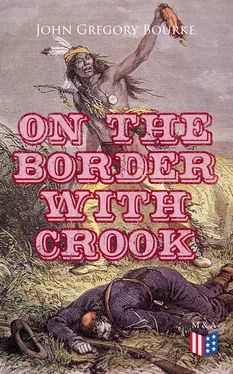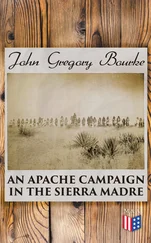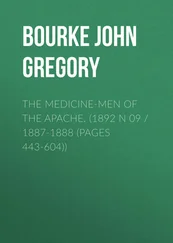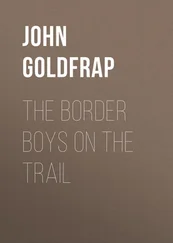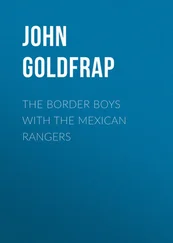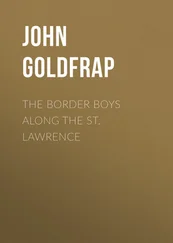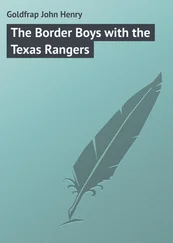One of the members of this last party was a beautiful young Mexican lady—Doña Trinidad Aguirre—who belonged to a very respectable family in the Mexican Republic, and was on her way back from a visit to relatives in Tucson.
That one so young, so beautiful and bright, should have been snatched away by a most cruel death at the hands of savages, aroused the people of all the country south of the Gila, and nothing was talked of, nothing was thought of, but vengeance upon the Apaches.
Cushing all this time had kept our troop moving without respite. There were fights, and ambuscades, and attacks upon “rancherias,” and night-marches without number, several resulting in the greatest success. I am not going to waste any space upon these, because there is much of the same sort to come, and I am afraid of tiring out the patience of my readers before reaching portions of this book where there are to be found descriptions of very spirited engagements.
The trail of the raiders upon the ranch at the “Cienaga” (now called “Pantano” by the Southern Pacific Railroad people) took down into the “Mestinez,” or Mustang Mountains, so called from the fact that a herd of wild ponies were to be found there or not far off. They did not number more than sixty all told when I last saw them in 1870, and were in all probability the last herd of wild horses within the limits of the United States. In this range, called also the “Whetstone” Mountains, because there exists a deposit or ledge of the rock known as “novaculite” or whetstone of the finest quality, we came upon the half calcined bones of two men burned to death by the Apaches; and after marching out into the open valley of the San Pedro, and crossing a broad expanse covered with yucca and sage-brush, we came to a secluded spot close to the San José range, where the savages had been tearing up the letters contained in one of Uncle Sam’s mail-bags, parts of which lay scattered about.
When the work-oxen of the Texans were run off, the Apaches took them over the steepest, highest and rockiest part of the Sierra Santa Catalina, where one would not believe that a bird would dare to fly. We followed closely, guided by Manuel Duran and others, but progress was difficult and slow, on account of the nature of the trail. As we picked our way, foot by foot, we could discern the faintest sort of a mark, showing that a trail had run across there and had lately been used by the Apaches. But all the good done by that hard march was the getting back of the meat of the stock which the Apaches killed just the moment they reached the cañons under the Trumbull Peak. Two or three of the oxen were still alive, but so nearly run to death that we killed them as an act of mercy.
Three of our party were hurt in the mêlée, and we scored three hits, one a beautiful shot by Manuel, who killed his man the moment he exposed himself to his aim, and two wounded, how seriously we could not tell, as by the time we had made our way to the top of the, rocks the enemy had gone with their wounded, leaving only two pools of blood to show where the bullets had taken effect.
The trail leading to the place where the Apaches had taken refuge was so narrow that one of our pack-mules lost his footing and fell down the precipice, landing upon the top of a tree below and staying there for a full minute, when the branches broke under him and let him have another fall, breaking his back and making it necessary to blow his brains out as soon as the action was over and we could take time to breathe.
Then followed the fearful scene of bloodshed known as the “Camp Grant Massacre,” which can only be referred to—a full description would require a volume of its own. A small party of Apaches had presented themselves at Camp Grant, and made known to the commanding officer that they and their friends up in the Aravaypa Cañon were willing and anxious to make peace and to stay near the post, provided they could get food and clothing. They were told to return with their whole tribe, which they soon did, and there is no good reason for supposing that the greater portion of them were not honest in their professions and purposes. The blame of what was to follow could not be laid at the doors of the local military authorities, who exerted themselves in every way to convey information of what had happened to the Department headquarters, then at Los Angeles. As previously stated, there was no mode of communication in Arizona save the stage, which took five days to make the trip from Tucson to Los Angeles, and as many more for a return trip, there being no telegraph in existence.
Weeks and weeks were frittered away in making reports which should have reached headquarters at once and should have been acted upon without the delay of a second. The story was circulated and generally believed, that the first report was returned to the officer sending it, with instructions to return it to Department headquarters “properly briefed,” that is, with a synopsis of its contents properly written on the outer flap of the communication when folded. There was no effort made, as there should have been made, to separate the peaceably disposed Indians from those who still preferred to remain out on the warpath, and as a direct consequence of this neglect ensued one of the worst blots in the history of American civilization, the “Camp Grant Massacre.”
A party of more than one hundred Papago Indians, from the village of San Xavier, led by a small detachment of whites and half-breed Mexicans from Tucson, took up the trail of one of the parties of raiders which had lately attacked the settlers and the peaceable Indians in the valley of the Santa Cruz. What followed is matter of history. The pursuing party claimed that the trails led straight to the place occupied by the Apaches who had surrendered at Camp Grant, and it is likely that this is so, since one of the main trails leading to the country of the Aravaypa and Gila bands passed under the Sierra Pinaleno, near the point in question. It was claimed further that a horse belonging to Don Leopoldo Carrillo was found in the possession of one of the young boys coming out of the village, and that some of the clothing of Doña Trinidad Aguirre was also found.
These stories may be true, and they may be after-thoughts to cover up and extenuate the ferocity of the massacre which spared neither age nor sex in its wrath, but filled the valley of the Aravaypa with dead and dying. The incident, one of the saddest and most terrible in our annals, is one over which I would gladly draw a veil. To my mind it indicated the weak spot in all our dealings with the aborigines, a defective point never repaired and never likely to be. According to our system of settling up the public lands, there are no such things as colonies properly so called. Each settler is free to go where he pleases, to take up such area as the law permits, and to protect himself as best he can. The army has always been too small to afford all the protection the frontier needed, and affairs have been permitted to drift along in a happy-go-lucky sort of a way indicative rather of a sublime faith in divine providence than of common sense and good judgment.
The settlers, in all sections of the West, have been representative of the best elements of the older States from which they set forth, but it is a well-known fact that among them have been a fair, possibly more than a fair, share of the reckless, the idle and the dissolute. On the other hand, among the savages, there have been as many young bloods anxious to win renown in battle as there have been old wise-heads desirous of preserving the best feeling with the new neighbors. The worst members of the two races are brought into contact, and the usual results follow; trouble springs up, and it is not the bad who suffer, but the peaceably disposed on each side.
Читать дальше
